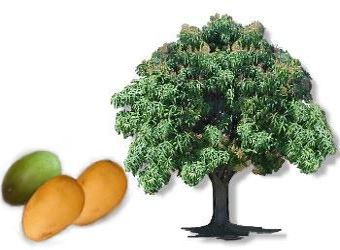 |
||
|
Home 10 DOH Herbs Adelfa Akapulko Ampalaya Balanoi Banaba Bayabas Bawang-Garlic Carrot | Karot Luyang Dilaw Gumamela Lagundi Mabolo Malunggay Makabuhay Niyog-Niyogan Oregano Pandan Pansit-pansitan Sabila Saluyot | Jute Sambong Silymarin Tanglad-Lemon Grass Tsaang Gubat Virgin Coconut Oil Yerba Buena |
Mango Tree(Mangifera indica, Anacardiaceae) |
|
A large evergreen tree, related to the cashew family (Anacardiaceae),
native to tropical Asia. This species is widely cultivated in many
tropical regions for its delicious fruit and often called the apple
of the tropics. Mango trees vary in height but may grow up to 100
feet and have widespread branches. Mango Trees have long life spans,
some trees have been known to be over 300 years old. The
lance-shaped leaves are dark green, but reddish when young, it has a
leathery texture and may be over 1 feet long. The tiny
yellowish-brownish flowers are borne in terminal clusters. These
flowers can be in the thousands per tree. Green fruits eventually
develop and take different shapes: oval, kidney and even round.
mangoes also vary in color: green, yellow to red. Depending on the
cultivar, sizes vary from 2 1/2 inches to 9 inches and may weigh up
to 2 kilograms. The fruit of the mango tree has thick, waxy smooth
skin while the flesh of the fruit has a peach-like texture, which is
rich, flavorful, juicy and sweet when ripe. |
||
|
|
||
Other Herbal & Non-Herbal Medicine: Philippine Plants, Fruits & TreesAbaca Plant | Avocado | Atis Fruit | Banana Plant | Barako Coffee | Coconut Palm Tree | Durian Fruit | Guyabano Fruit | Mango Tree | Mangosteen | Papaya Nutrition Facts | Pineapple | Rubber Tree | Tomato Nutrition Facts | Tuba-Tuba Plant - Jatropha Key to Nutritional Healing | Philippine Medicinal Plants List |
||
|
Philippine Herbal Medicine © 2005-2024 |
||
 The Mango Tree
The Mango Tree